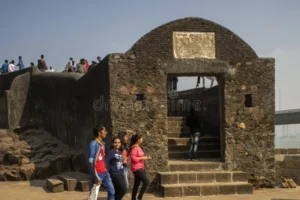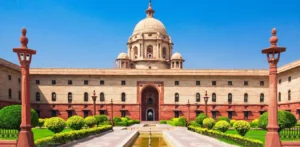Indian modern art and architecture combine traditional and modern elements to express the nation’s changing character. While painters like M.F. Husain and Amrita Sher-Gil introduced modernism and combined Western techniques with Indian topics, groups like the Bengal School brought back Indian themes in painting. The Progressive Artists’ Group emerged in the post-independence era, rejecting academic realism and experimenting with new Indian culturally inspired forms.
The Indian modern art and architecture was characterized by modernist projects such as Le Corbusier’s Chandigarh and works by architects like B.V. Doshi and Charles Correa, who combined climate-responsive designs with indigenous materials. High-rise urban complexes, environmentally friendly building designs, and famous buildings that combine cutting-edge engineering and conventional design, such as the Lotus Temple and Akshardham Temple, are examples of India’s contemporary architecture. Collectively, contemporary
Indian modern art and architecture
Portuguese influence
The Portuguese brought with them the Iberian style of Indian modern art and architecture. In the beginning he constructed trading places and warehouses. These later transformed into fortified cities along the seacoast. He popularized the concept of ‘courtyard house’ and ‘Barbecue discussion’ in the Iberian in style.

Notable creations
The se cathedral of goa was completed in 1619 AD. It was built in Portuguese Gothic style. It has a huge bell. Which is called ‘Golden Hour. It’ i.e. Golden Bell. The Basilica of Bom Jesus ‘Holy Jesus goa. Was completed in 1604 AD. It houses the venerated body of St. Francis Xavier.
Castellar de Aguanda Mumbai
Church of Saint Paul in Diu. It is built in baroque style and was completed in 1610 AD.
Divu Fort was built in 1535 on the coast of Divu Island. There are three churches in the premises of this fort namely- St, Thomas church, St Paul’s church and the Church of St. Francis of Assisi. Church of St. Anne, talaulim in goa. It is in Baroque style and was completed in 1695 AD.

French influence
The French brought with them the concept of urban planning. Pondicherry and Chandan agar. (now Chandan agar, west Bengal) created cartesian grid plan and scientific architecture. The French captured coastal towns like Mahe (Kerala), Karaikal (Tamil Nadu) and Yanam. (Andhra Pradesh) also developed.
The French also developed coastal towns such as Mahe (Kerala), Karaikal (Tamil Nadu) and Yanam (Andhra Pradesh).
Example: Sacred heart church of Jesus in Puducherry. Sacred heart church of Chandan agar.
British Influence
The British brought with them the Gothic style of Indian modern art and architecture. It merged with Indian architecture and resulted in the Indo Gothic style of Architecture. After 1911, a new style of architecture known as Neo-Romanesque architecture emerged.
Indo-gothic style
Known as Victorian style, this architecture was a unique blend of Indian, Persian and Gothic style, the square of the Indo Islamic era, the arches contrasted with the car arches were pointed, a unique feature of the Victorian style was the use of huge windows. Examples: Victoria Memorial in Kolkata, Gateway of India in Mumbai etc.
Difference Between Iberian and Gothic Architecture
Iberian architecture
The main building material used by the Portuguese was bricks, wood was used for roofs and stair, Portugal Leo continued their Western traditions now.
Gothic architecture
Mainly red sandstone and coarse limestone were used, the British adopted Indian motifs and styles
Neo-Roman style
The Indian modern art and architecture of New Delhi, done by Edwin Lutyens and Herbert Baker, is the best example of this style. It is often described as the Rome of India.The features of this phase are as follows: It was a confluence of all styles of architecture. More attention was paid to circular buildings. The concept of a raised dome was circulated during this phase. It can be seen on the top of the Supreme Court and the Rashtrapati Bhavan.

Post-Independence Architecture
Two styles of Indian modern art and architecture emerged after 1947, the revival and the influence of colonial survival was visible on both the Avadi and Modernist styles. The level of architectural tradition of India declined, for example, the Punjab government had hired the services of French architect Kaburjiyer to design the city of Chandigarh.
Lori Baker
Lori Baker is also known as the architect of the poor in Mr. Baker’s accountability for the revolutionary collective housing concept in Kerala. In 2006 he was nominated for the Prinker’s Prize, also known as the Nobel Prize for Indian modern art and architecture. He emphasized on comfortable ventilation and warmth. He is called the conscience of Indian architecture and the Gandhi of Indian architecture.
Charles Korea
He is known for his urban architecture and the work he did in local planning, adapting Indian modern art and architecture. principles to local sensibilities and requirements. He was awarded the Padma Vibhushan in 2006 by designing the Mahatma Gandhi Memorial Museum in Madhya Pradesh Vidhan Sabha Building, Ahmedabad, New Delhi, etc. We see that art and architecture found a unique expression in the life and leisure of the people of India right from a prehistoric period.
conclusion
The vibrant interaction of tradition and innovation is a defining feature of modern Indian art and architecture. The effort to identify and express a distinct cultural identity in a world that is fast globalizing is reflected in them, as well as India’s path from colonization to freedom. India’s contemporary architects and artists continue to add to the world’s cultural environment, whether it is by experimenting with cutting-edge technology or by resurrecting old forms.
Here are some frequently asked questions (FAQs) about modern Indian art and architecture:
Indian modern art and architecture
Q1: What are the key characteristics of modern Indian art?
- Modern Indian art is characterized by the fusion of traditional Indian themes with modernist styles, experimentation with new forms, and a focus on social issues, identity, and the intersection of tradition and modernity.
Q2: Who are some prominent modern Indian artists?
- Prominent modern Indian artists include M.F. Husain, F.N. Souza, Amrita Sher-Gil, S.H. Raza, Subodh Gupta, and Bharti Kher.
Q3: What was the Bengal School of Art?
- The Bengal School of Art was an early 20th-century movement that sought to revive Indian artistic traditions, using themes from Indian mythology, history, and everyday life, as a reaction against Western academic realism.
Q4: How did the Progressive Artists’ Group influence Indian art?
- Formed in 1947, the Progressive Artists’ Group sought to break away from colonial influences and academic realism, embracing modernist techniques while grounding their work in Indian culture and themes.
Q5: What are some iconic examples of Indian modern art and architecture?
- Iconic examples include Chandigarh, designed by Le Corbusier; the Indian Institute of Management Ahmedabad by Louis Kahn; the Lotus Temple in Delhi; and sustainable projects by architects like B.V. Doshi and Charles Correa.
Q6: How has post-independence architecture in India evolved?
- Post-independence architecture in India has evolved from modernist projects like Chandigarh to a blend of brutalism, sustainable architecture, and contemporary designs that respond to local climates and materials.
Q7: What is sustainable architecture in India?
- Sustainable architecture in India focuses on eco-friendly designs that use local materials, green technologies, and traditional building techniques to create structures that are environmentally responsible and culturally relevant.
Q8: How do Indian modern art and architecture, temples blend tradition with modernity?
- Indian modern art and architecture, temples, like the Akshardham Temple and Lotus Temple, blend traditional architectural styles with modern engineering and materials, creating spaces that reflect both ancient and contemporary spiritual aesthetics.
